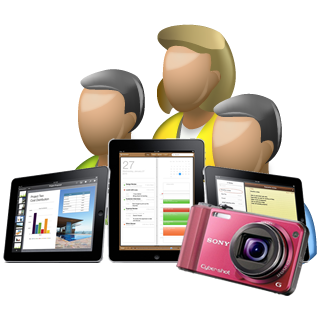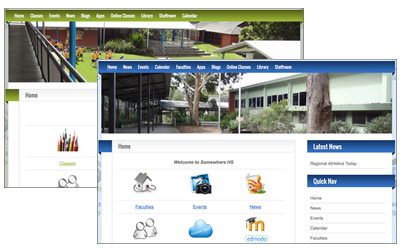 Of the many components in a school’s learning environment, the most constantly-changing physical component is undoubtably ICT.
Of the many components in a school’s learning environment, the most constantly-changing physical component is undoubtably ICT.
The speed of this change has been accelerating as the broader community rapidly adopts and ‘normalises’ the use of online and mobile technologies in their day-to-day lives.
In comparison with this community background, many schools’ ICT offerings are now looking a little tired and outdated. Lots of ‘same-old’ ICT has been happening in many schools for the last 10 years – research, copy, paste, summarise, print, hand-in!
So, where do we start when planning to haul a school into the modern ICT era? How do we give our school an ICT makeover so that the curriculum transparently embraces new and emerging technologies?
| Here are seven key ingredients to be considered when planning a school ICT makeover…… | |
 |
|
| 1. | Encourage all staff to ‘adopt & adapt’ |
 |
 Right from the start, let’s focus on people, rather than infrastructure issues such as servers, switches, cabinets, Ethernet, wireless access points, optic fibre, and so on. If teachers don’t personally use online technologies, curriculum integration of ICT will never happen in their classrooms, regardless of the capacity of your server, or the speed of your network. Right from the start, let’s focus on people, rather than infrastructure issues such as servers, switches, cabinets, Ethernet, wireless access points, optic fibre, and so on. If teachers don’t personally use online technologies, curriculum integration of ICT will never happen in their classrooms, regardless of the capacity of your server, or the speed of your network.
Personal adoption of new technologies by teachers will inevitably lead to them adapting and implementing those technologies in their classrooms. There is a huge difference between ‘lip-service, ticking the box, doing computers’ in classrooms, and truly engaging with online environments as part of an inspiring teaching and learning environment. There are many different ways to make this happen, but providing opportunites for teachers to share ideas and success stories can be a valuable part of the basic foundation. Is someone in your school travelling overseas in the next holiday break? Get them interested in using TripIt to organise their itinerary. Or, if they like writing, help them to setup a travel blog at WordPress or Blogger, or maybe a shared photo album at PicasaWeb, or maybe use a note-taking app like Evernote. They can keep a copy of their travel documents in their Dropbox folders. Maybe they are already using Facebook, which functions on a similar ‘anytime, anywhere, any device’ model. Explore the advantages of accessing all this info on a smartphone or iPad. All useful tools in anyone’s non-work life. When your school returns from the holiday break, encourage teachers to share some stories of their travels at your first staff meeting, supported by a photo slide show – maybe using an online album, rather than a local application. An absolute ‘must’ is to encourage every teacher to setup their own personal email account, rather than using their school’s corporate email for non-school communications. Gmail is the obvious choice. It is free, and has a heap of other attached services, most notably the Google Apps suite. And, of course, leading from the top is important too. Avoidance of the use of personal technologies (as opposed to corporate technologies) by the school leadership sends a clear (negative) message to other staff. Getting started with the cloud – Useful Personal Technologies: |
| 2. | Hardware ownership & distribution |
 |
 Over the last few years the digital world has changed. Big time….. Over the last few years the digital world has changed. Big time…..
When you need to know something, you get online. And for most of our students, that usually means reaching into their pocket for a smartphone. It doesn’t mean waiting until Thursday morning at 11 am for their scheduled visit to the school Library or computer room. Online technologies need to be available whenever required during class time. The days of a whole class trooping to the ‘lab’ for mass technology ‘instruction’ are over in innovative schools. Sure, a central grouping of desktop computers can still play a useful role, but generally this should be provided as a small part of a more widely-dispersed ICT environment. While some schools are heading down the 1:1 path to provide this ‘anytime-anywhere’ environment, this is not always achievable in all schools. The next best thing is to distribute resouces in such a way that appropriate technlogoes are available as widely as possible on an ‘as-needed’ basis. This might be a combination of a few desktop computers in each classroom, along with some ‘floating’ iPads that are accessible by students when needed. Or maybe explore the possibilities of supplementing school-owned hardware by implementing a program where students and teachers can use their own mobile technology on the school network. (See BYOT example below.) Another option is to make portable school technologies available for group work, where the groups of students are well-versed in sharing and other group dynamics. Your school will need a robust network and, most importantly, a carefully planned wireless network for any of this to happen – no network, no online activities! Even worse than no network is a network that is unable to fully support the needs of staff and students, A ‘flakey’ network will discourage hesitant users from returning for a second dose. |
| 3. | File access & storage |
 |
A similar model was used to setup most schools’ current technology infrastructures. Times have changed. Innovative teachers and students expect to be able to access their stored data whenever they feel the need. And carting around a thumb-drive doesn’t cut it anymore! If I sit at a desktop computer in the school staffroom and create a document, I want to be able to edit that document at home on my laptop, or share it with others at a meeting at another school on my iPad. Anytime, anywhere. If a student begins work on a project in their classroom, they expect to be able to edit their work in the school library, or at home, or maybe at the town library after school, on whatever platform they prefer to use. Desktop, laptop, or other mobile device. Without worrying about having the correct version of software installed on each device. The traditional file-server at the centre of the school network is fast becoming a dinosaur. Unless you are able to provide a huge file-storage capacity, and make files stored on your server accessible 24/7 from any location on a variety of devices, your server technology is only going to impede the progress of enthusiastic teachers and students. Even worse, it will be bypassed by innovative students and teachers in favour of other more accessible options. As part of an accessible model, we need to rethink what software we use, and how we store the files created by teachers, students and school administrators. Google Apps for Education is an obvious option to consider. This service provides every teacher and student with universal access, unlimited space for personal email and file storage, along with a suite of software, accessible on multiple devices from any location with internet access. All for free. If your school isn’t able to go down the full Google Apps path (maybe because of school network/policy restrictions), you might explore individual Google accounts, or other ‘cloud’ options such as Dropbox and Box. If your office admin and executive staff, for example, share documents (such as the school newsletter) with each other, why not set them up with a free Dropbox account, and some shared folders for their collaborative files? Or move the newsletter format over to Google Apps, and share the newsletter file with the relevant contributors? These files will be accessible from any computer, laptop, tablet or smartphone, from school or home, and all backed up for free, with no effort on the part of any school personnel. Maybe try the same model with Stage or Year teachers. Or the school executive. Create free accounts and experiment with online file storage: |
| 4. | Professional Collaboration |
 |
Most teachers are comfortable with the idea of storing files in their home folder on the school server. So storing files on a cloud service such as Drive or Dropbox shouldn’t be too much of a leap. Once the move to the cloud has been implemented, the sharing of stored documents is a logical step. Co-editing shared documents is a useful tool for administrators working on shared documents. It shouldn’t be too hard for teachers to see the benefits of using the same technologies in class. Getting started:
|
| 5. | Classroom Activities |
 |
It is a tired old model – do some ‘research’ (ie – type a few words into Google), copy and paste some text and pictures from the web browser into a word processing document, tart it up with some fancy headings, print it on the colour printer, and then hand it in for assessment. Or (if you are real leading-edge) present it as a slide-show. If your school Internet connection is being used as little more than a big encyclopedia, then it’s time to visit some innovative schools for some new ideas. Students should be using online environments to collaborate, share ideas, develop new ideas and gain new perspectives through interactive discussions. Creativity, critical thinking, problem-solving, decision-making, communication and collaboration should be at the heart of a modern classroom. Online classroom activities can also foster a sound understanding of personal and social responsibilities in the broader online world. Online forums such as Facebook are the norm for most secondary students outside of school. Schools can emulate and build on these environments with wikis and blogs, or more formal tools such as Google Classroom, Edmodo and Moodle. Sure, researching, synthesising, analysing and presentation options remain important skills, but there is now a whole new dimension to learning environments that is likely to be stymied by a blinkered approach to the application of ICT in schools. If students go to ‘the lab’ once a week to use ‘technology’ then they are unlikely to ever get past the ‘research, copy, paste, submit’ model. Innovative online activities won’t have a place in a school that doesn’t encourage universal technology access through the use of ‘anytime anywhere’ hardware and software options.
|
| 6. | The Online Classroom |
 |
The provision of a relevant and meaningful curriculum involves embracing this ‘always online’ world in our classrooms. Successful schools ‘normalise’ the digital environment – the network is always accessible to support students and teachers, not just during ‘technology’ classes. When anyone in your school opens a web browser, there should be an easy mechanism for them to access the school’s online resources – be that individual classroom resources, or whole school resources. (Of course, these resources also need to be created over time.) The obvious starting point to make this happen is a default school or class web site. However, essential extensions of what might be a fairly static web site environment are wikis and blogs, and tools such as Edmodo and Moodle. The online classroom goes far beyond the school fence. Online school environments must be accessible from outside the school for both students and teachers. And most likely by students and teachers from other schools. It is worthwhile to undertake a survey of your staff and students to discover and understand the potential accessibility of your online resources beyond the school’s physical boundaries. Do students have internet access at home? If their home has internet access, do they have equitable access to devices to connect to the network? Are teachers confident and capable in providing an online component to their existing curriculum? So, there are two aspects to consider – the creation of online resources (which will no doubt involve a large PD component for teachers) and the ability of students to access these resources 24/7.
Compare the options for creating free online web resources for your class:
Check out Google Classroom
|
| 7. | Your School Web site |
 |
What messages does your school web site convey? Is your school an active and dynamic learning community? Are students considered as individual learners? Or is your school a tired and uncaring arm of a systemic sausage factory that is ‘ticking boxes’ and churning out mass-produced clones? If your school’s web site is individually tailored to reflect the tone and values of your physical learning environment, and regularly updated with information about local school events and activities, those accessing the site will come to understand that this philosophy is likely to be mirrored in your learning programs. If your school’s web site is a ‘cookie-cutter’ site, carrying corporate messages, and little local content, you could be seen as providing a distant, uncaring corporate environment for students. In days gone by, school web sites often fell into disrepair because they were created using ‘local’ applications which were stored on one computer, accessible by only one person. New opportunites are now available using online applications that create web sites that can be edited from any computer or device with an Internet connection. Some ideas…. Compare the options for creating free online web resources for your class:
Experiment with creating your own ‘cloud’ web site…. Create a free site and start experimenting at: Read about the role of school web sites:
|

 Introducing new ideas often involves moving people from the known to the unknown.
Introducing new ideas often involves moving people from the known to the unknown. The advent of the Internet in schools in the late 1990s provided every school library with a whole new online encylopedia – and it was (and often still is) used in the same way printed encyclopedias were used 20 years ago.
The advent of the Internet in schools in the late 1990s provided every school library with a whole new online encylopedia – and it was (and often still is) used in the same way printed encyclopedias were used 20 years ago. The network is everywhere. Not just at your desk at school. It is available at home, at the shops, in the park, on public transport, and in the car.
The network is everywhere. Not just at your desk at school. It is available at home, at the shops, in the park, on public transport, and in the car. Every school has a web site. Your web site is your public online face, where the local community interacts with the school – and your web site says a lot about your school’s philosophies and values.
Every school has a web site. Your web site is your public online face, where the local community interacts with the school – and your web site says a lot about your school’s philosophies and values.